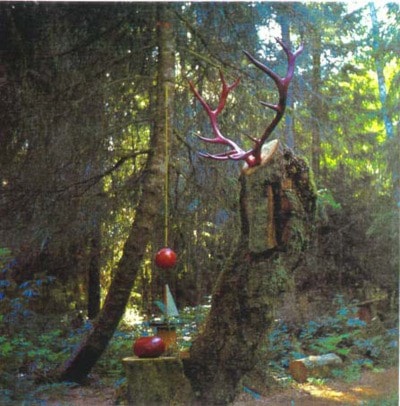There'll never be another George.
To call George Sawchuk a unique character is an understatement 100 miles wide. But he was a logger, artist, philosopher and friend to all. He loved to talk and share a glass of whiskey. He was generous, humble and often funny.
George Sawchuk's wood sculptures have graced galleries in Washington, D.C., the University of B.C. and in the Comox Valley. In 2008 he received the honorary title of Valley Treasure from the Comox Valley Community Arts Council and one of the small galleries in the Comox Valley Art Gallery (CVAG) was given his name.
On Feb. 2, the 85-year old died in his sleep at his Fanny Bay home. A short tribute to Sawchuk will be given at CVAG by former curator Tony Martin on March 9 at 7:30 p.m. A gathering for family and friends will be held this summer.
I discovered George Sawchuk's Wacky Woods by accident.
As I strolled along a Fanny Bay trail, a wooden sign saying Bus Stop persuaded me to take a less-travelled path. As more carvings — frequently adorned with sinks, clocks, mirrors and other objects — appeared I felt like a modern-day version of Alice in Wonderland after she tumbled down the rabbit hole.
After walking some distance I heard opera music and through the trees glimpsed a large garden and modest house. I was too shy to go closer but spotted a small tablet and pencil and scribbled, "I don't know who you are, but this is wonderful!"
Born in Kenora, Ont., in 1927, Sawchuk wasn't one of those youngsters that displayed a talent for art an early age. He put in 30 years first, as a logger, fisherman and construction worker.
Then lived a decade of pain after his leg was crushed in an industrial accident. Relief came in 1968 when, as Sawchuk put it, "They bucked it off."
A disability pension provided time to visit the library. He started reading about Picasso and thinking about art.
In a 2008 interview he said, "Then a fellow that owed me money gave me a chainsaw. All of a sudden I had time, a saw and a guaranteed income."
The urge to create was strong. But Sawchuk wanted to do something truly Canadian. So he took his chainsaw into the back of his North Vancouver property and began carving.
His neighbour, artist Ian Baxter, noticed. Within 10 years Sawchuk had received a Canada Council grant, was elected to the Royal Academy of Arts and had sculptures in the Art Bank of the Canada Council.
In 1974, Sawchuk and wife, Pat Helps, bought four acres in Fanny Bay. They cleared the land by hand, tilled a huge vegetable patch and built a house. Then Sawchuk got to work on the rear of the property, clearing little paths and carving sculptures.
Eventually his artistic work wandered over the property line onto Crown land. Government officials told Sawchuk to remove his work but a public outcry and impressive show of support from the arts community resulted in the demands being dropped and the area becoming a park.
And so Sawchuk's work became not only truly Canadian, but also truly public art.
Martin has known Sawchuk as friend and artist since 1979.
"A bunch of us used to get together and go down to George and Pat's on a regular basis," he says. "George would talk and tell stories and Pat would make sure everyone was comfortable and had everything they needed.
"George was a very genuine person, not pretentious at all," continues Martin. "And he had an incredibly intuitive way of creating art. He used everyday tools to carve, embellishing the pieces with found objects to create vignettes.
"I was really pleased that CVAG could provide permanent recognition for him through one of the galleries."
"A question often asked in the realm of public art is what do artists bring to public art that architects and landscape artists don't?" says artist Ed Varney. "I think the answer to that question is whimsy.
"George's art had that clever sense of humour and we are so lucky to have his Wacky Woods as a public venue. People don't always agree with the sentiment of George's work but they love that site."
In later years, a bum knee and asthma made it increasingly difficult for Sawchuk to get around. As well as looking after the house, yard and garden, Pat provided refreshments for the frequent visitors and nursed Sawchuk in his last months.
"She was a real mainstay for him," says Tony Martin. "She was always there looking after whatever needed to be done."
The weeks after Sawchuk's death people were tramping through his Wacky Woods, not minding the muddy ground or dripping leaves. Although the public art is still there for everyone to see, enjoy and touch free of charge, like all living entities, it is changing.
Trees decay and topple, bark grows over mirrors and bits of metal rust. But just like Sawchuk, the memory of its magical presence will live on in the hearts of all who have known the man and experienced his art.
"You can't get more Canadian than George," noted Comox Valley Community Arts Council director Robert Moon upon presenting Sawchuk with the inaugural CVCAC Valley Treasure Award. "He spent the first half of his life cutting down trees and the second half paying homage to them with his provocative sculptures. He is a true Valley icon."
